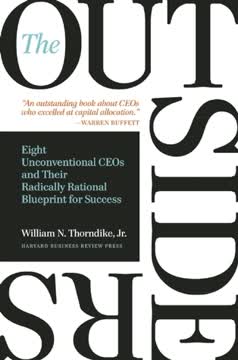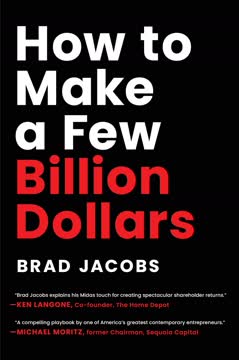重点摘要
1. 通过收购创业:通往企业所有权的独特路径
你现在可以购买一家现有的小企业,并担任CEO。
新的创业途径。 通过收购创业为传统的企业职业或风险较高的初创企业提供了一个引人注目的替代方案。这条路径允许专业人士成为已建立企业的CEO,利用他们的管理技能和经验。机会广泛,仅在美国就有估计20万家合适的企业。
财务和生活方式的好处。 收购小企业可以提供显著的财务回报和生活方式的灵活性。所有者通常会结构化交易以保留有意义的经济权益,可能获得可观的投资回报。此外,经营自己的公司提供了更大的工作与生活平衡的控制权,并能够做出有影响力的决策。
- 主要优势:
- 立即担任领导角色
- 潜在的高财务回报
- 工作与生活平衡的灵活性
- 应用一般管理技能的机会
2. 识别合适的小企业进行收购:持久盈利是关键
持久盈利企业的基本特征是有回头客。
关注稳定性。 理想的收购目标是具有持续盈利历史和缓慢、稳定增长的已建立企业。这些“无趣”的企业通常提供了长期成功和降低风险的最佳机会。
持久盈利企业的特征:
- 回头客
- 良好的声誉
- 有限的竞争
- 对客户成本的相对小部分
- 与客户运营的整合
避免高增长、技术驱动或周期性企业,因为它们通常伴随着更高的风险和更高的购买价格。相反,寻找具有稳定现金流和经过验证的商业模式的公司,这些公司你有能力有效管理。
3. 为收购融资:平衡债务、股权和卖方融资
买家通常通过借款支付约三分之二的购买价格来收购小公司。
典型的融资结构:
- 30-50% 高级债务(银行贷款)
- 20-25% 卖方融资
- 剩余部分来自股权投资者
利用多种来源。 成功的收购通常涉及债务和股权融资的组合。来自银行或小企业管理局(SBA)的高级贷款可以以优惠条件提供购买价格的很大一部分。卖方融资表明卖方对企业的信心,并在收购后将其利益与买方的利益对齐。
股权考虑。 从投资者那里筹集股权对于完成收购至关重要。投资者通常期望每年约25%的回报,以应对小企业私募股权投资的风险。结构化交易以提供有吸引力的回报,同时保留足够的所有权给自己。
4. 寻找潜在收购目标:利用经纪人和直接接触
通过经纪人寻找是克服首次卖家不确定性问题的最成功方法。
经纪人的优势。 与商业经纪人合作可以简化收购过程。经纪人提供有关待售公司的有组织信息,帮助管理卖方期望,并促进买卖双方之间的沟通。
直接寻找方法。 另外,直接联系企业主可以发现非市场机会,并可能达成更好的交易。这种方法需要更多的努力,但可以带来独特的前景。
- 寻找策略:
- 与多个经纪人建立关系
- 使用Axial或Dealnexus等在线平台
- 针对目标行业/地区的企业主进行定向接触
- 利用个人和专业网络
平衡这两种方法,以最大化找到合适收购目标的机会。准备好审查数百个潜在目标,以确定合适的机会。
5. 尽职调查:彻底调查以验证商业机会
尽职调查是一个你引导的迭代过程。
全面评估。 尽职调查对于验证你对企业的理解并发现任何潜在问题至关重要。这个过程包括对公司运营、财务和市场地位的定性和定量评估。
重点领域:
- 财务表现和会计实践
- 客户关系和满意度
- 法律和监管合规
- 运营效率
- 管理团队能力
- 行业趋势和竞争格局
聘请专业顾问(会计师、律师)协助尽职调查的专业方面,但要积极参与整个过程。利用调查结果来完善你的财务预测和收购策略。
6. 谈判交易:制定双赢的意向书(LOI)
意向书是握手协议,允许双方以合理的信心继续进行。
谈判框架。 意向书(LOI)作为收购的路线图,概述了关键条款,如购买价格、融资结构和收购后的承诺。虽然不具约束力,但它设定了期望并展示了双方的承诺。
意向书的关键组成部分:
- 购买价格和支付结构
- 融资细节(包括卖方融资)
- 尽职调查期和排他性
- 关键员工保留计划
- 收购后过渡安排
谈判保护你利益的条款,同时对卖方保持公平。根据尽职调查的发现准备调整,但除非绝对必要,否则避免重新讨论已解决的问题。
7. 完成收购:应对法律复杂性并最终确定协议
你现在在三个不同的方面推进收购:完成确认性尽职调查,与贷款人合作完成他们的尽职调查并谈判贷款协议,以及与股权投资者最终确定股东协议。
协调多个工作流。 收购的最后阶段涉及同时完成尽职调查、确保融资和最终确定法律协议的努力。这个过程需要仔细协调和关注细节。
关键的收购完成考虑:
- 购买协议谈判
- 融资文件(银行贷款、卖方票据)
- 股权投资协议
- 雇佣和竞业禁止协议
- 监管批准(如适用)
与法律顾问密切合作,确保所有必要文件正确准备和执行。准备好应对最后一刻的问题,并在寻找解决方案时保持灵活性。记住,收购完成不是结束,而是你作为企业主旅程的开始。
最后更新日期:
FAQ
What's "HBR Guide to Buying a Small Business" about?
- Overview: The book is a comprehensive guide on how to successfully purchase and manage a small business. It is part of the Harvard Business Review Guides series.
- Authors: Written by Richard S. Ruback and Royce Yudkoff, both professors at Harvard Business School, the book draws on their extensive experience in teaching and researching entrepreneurship through acquisition.
- Target Audience: It is aimed at managers considering a career change, newly minted MBAs, or anyone interested in becoming a business owner through acquisition.
- Content Structure: The book is divided into five parts, covering everything from preparing for a search to completing the acquisition and transitioning into ownership.
Why should I read "HBR Guide to Buying a Small Business"?
- Practical Guidance: The book offers step-by-step instructions on how to find, evaluate, and purchase a small business, making it a practical resource for aspiring entrepreneurs.
- Expert Insights: It provides insights from Harvard Business School courses, making complex concepts accessible to a broader audience.
- Financial Opportunities: The book highlights the financial benefits of buying a small business, such as potential high returns on investment.
- Risk Management: It offers strategies for mitigating risks associated with buying and running a small business.
What are the key takeaways of "HBR Guide to Buying a Small Business"?
- Entrepreneurship Through Acquisition: The book emphasizes buying an existing business as a viable path to entrepreneurship, offering both financial rewards and career flexibility.
- Enduring Profitability: Focus on acquiring businesses with recurring customers and stable cash flows to ensure long-term success.
- Due Diligence: Conduct thorough due diligence to confirm the business's financial health and the seller's commitment to sell.
- Financing Options: Explore various financing options, including bank loans, seller financing, and equity from investors.
What are the best quotes from "HBR Guide to Buying a Small Business" and what do they mean?
- "Think Big, Buy Small": This quote encapsulates the book's philosophy of achieving significant career and financial goals by acquiring a small, enduringly profitable business.
- "The Opportunity: Entrepreneurship Through Acquisition": This highlights the book's central theme that buying a business is a practical and rewarding path to entrepreneurship.
- "Managing the Risks of Ownership": This quote underscores the importance of understanding and mitigating the risks involved in owning a small business.
- "Reaping the Rewards: The Financial Opportunity": It emphasizes the potential financial benefits of buying a small business, such as high returns on investment.
How do I determine if entrepreneurship through acquisition is right for me according to the book?
- Self-Assessment: The book suggests evaluating your values, goals, and skills to determine if this path aligns with your personal and professional aspirations.
- Independence and Rewards: Consider if you value professional independence and direct rewards for your efforts, as these are key aspects of owning a business.
- Emotional Resilience: Assess your ability to handle the emotional ups and downs that come with entrepreneurship.
- Learning and Adaptability: Be prepared for continuous learning and adapting to new challenges in managing a business.
What is the acquisition process outlined in "HBR Guide to Buying a Small Business"?
- Four Phases: The process is divided into four phases: preparing for your search, finding the right business to buy, making an offer, and completing the acquisition.
- Preparation: This involves understanding the costs, raising funds, and identifying the characteristics you want in a business.
- Finding and Filtering: Source prospects through brokers or direct outreach and apply filters to identify viable acquisition targets.
- Due Diligence and Negotiation: Conduct thorough due diligence, negotiate terms, and finalize the purchase agreement.
How does the book suggest financing the acquisition of a small business?
- Debt and Equity: The book recommends using a combination of debt (bank loans, seller financing) and equity from investors to finance the purchase.
- Senior Loans: These are typically used to cover a significant portion of the purchase price and are secured against the business's assets.
- Seller Financing: This involves the seller providing a loan to the buyer, which is repaid over time, aligning the seller's interests with the business's success.
- Equity Investors: High-net-worth individuals can provide equity, expecting a return on investment, usually around 25% annually.
What are the characteristics of an enduringly profitable business according to the book?
- Recurring Customers: Businesses with a stable customer base that makes repeat purchases are considered enduringly profitable.
- Strong Reputation: A good reputation can keep customers loyal and deter competitors.
- Low Competition: Businesses with few competitors or high barriers to entry are more likely to maintain profitability.
- Stable Cash Flows: Consistent cash flows indicate financial health and reduce the risk of business failure.
How does "HBR Guide to Buying a Small Business" recommend conducting due diligence?
- Preliminary Due Diligence: Focus on understanding the business model, financials, and potential deal-breakers.
- Confirmatory Due Diligence: Validate initial findings with detailed financial analysis, legal checks, and customer and employee interviews.
- Professional Advisors: Engage accountants and lawyers to assist with financial and legal due diligence.
- Iterative Process: Continuously update your understanding of the business as new information becomes available.
What are the potential risks and rewards of owning a small business as outlined in the book?
- Risks: These include financial loss, management challenges, and market competition. The book emphasizes the importance of risk mitigation strategies.
- Rewards: Potential rewards include financial independence, high returns on investment, and personal fulfillment from running a successful business.
- Risk Management: The book advises buying businesses with stable cash flows and recurring customers to minimize risks.
- Long-Term Success: Focus on businesses with enduring profitability to ensure long-term success and financial stability.
How does the book suggest managing the transition after acquiring a business?
- Employee Communication: Clearly communicate your role and plans to employees to ensure a smooth transition.
- Cash Management: Implement a cash flow management system to avoid financial pitfalls.
- Customer Engagement: Meet with key customers to understand their needs and build relationships.
- Gradual Changes: Avoid making major changes immediately; take time to learn about the business before implementing new strategies.
What are the common mistakes to avoid when buying a small business according to the book?
- Overpaying: Avoid overpaying by conducting thorough due diligence and negotiating a fair price.
- Ignoring Red Flags: Pay attention to any red flags during due diligence, such as inconsistent financials or uncommitted sellers.
- Underestimating Costs: Be aware of all costs involved, including acquisition costs, working capital needs, and potential liabilities.
- Lack of Preparation: Ensure you are well-prepared for the acquisition process, from financing to transition management.
评论
《HBR小企业购买指南》因其实用且详细的收购小企业建议而备受赞誉。读者们欣赏其循序渐进的方法,涵盖了从寻找资源到尽职调查的所有内容。书中强调了“持久盈利”的企业及其忠实客户,这被认为是宝贵的见解。许多评论者认为这本书是首次购买者的必备资源,提供了清晰的指导和现实的例子。一些人指出某些方面可以更详细,但总体而言,这本书被认为是任何考虑收购小企业的人必读的书籍。
Similar Books














